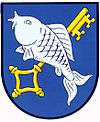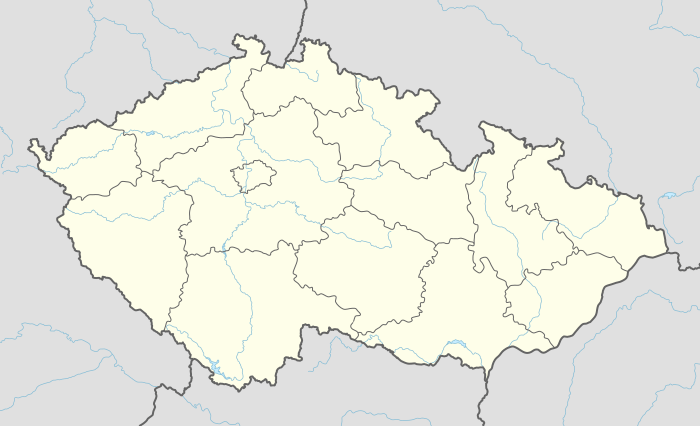Lnáře
Lnáře (German: Schlüsselburg, in English Lnar) is a small municipality in the Czech Republic located 35 kilometres (22 mi) northwest of Písek city or 50 kilometres (31 mi) southeast of Pilsen. It is situated on the shores of three ponds within municipal borders in the northwest corner of the formerly autonomous Prachens Region, today in the Strakonice District, South Bohemia.
Lnáře | |
|---|---|
village | |
Lnáře's centre: the Old Stronghold and New Chateau (in the background) on the shore of Zámecký Pond | |
 Flag  Coat of arms | |
 Lnáře Location in the Czech Republic | |
| Coordinates: 49°27′29″N 13°47′16″E | |
| Country | Czech Republic |
| Region | South Bohemian |
| District | Strakonice |
| Municipality | Lnáře |
| First mentioned | 1318 |
| Government | |
| • Mayor | Lady Stanislava Mašková |
| Area | |
| • Total | 12.51 km2 (4.83 sq mi) |
| Elevation | 565 m (1,854 ft) |
| Population (2009-28-02) | |
| • Total | 734 |
| • Density | 59/km2 (150/sq mi) |
| Time zone | UTC+1 (CET) |
| • Summer (DST) | UTC+2 (CEST) |
| Postal code | 387 42 |
| Website | www.lnare-obec.cz |
The name of municipality is derived from the Slavonic word len ("flax") and combined with a suffix which gives a meaning of "flax-makers" or "flax producers". The German name has different etymology: Schlüssel means "key" and Burg means "stronghold, castle"; according to ancient legend, a golden key was found by plougher on the building site of local New Chateau.
History
The municipality is the former centre of a vast agrary husbandry including two small towns and about 50 villages in its proximity (only the small settlement Zahorčice is still administered by Lnáře). Such was the situation between the mid-15th century and the mid-19th century. After this period of relative prosperity (with a few pauses incurred by civil convulsions) emerged an era of nationwide population decline in all counties in Central Europe (with exceptions in entirely undeveloped mountainous counties in the Carpathian Mountains system etc.), and the local population significantly decreased to the current number of fewer than 750 people.
Municipality have got traces of human settlement since 7th–6th centuries BC. As proof are left burying-grounds with remains of funeral equipment on the shores of pond Měleč close to the municipality. Although continually inhabited, some influx of Slavs also occurred in the 8th century. Since 13th century, the settlement has been denser and small stronghold from wood was built.
The oldest mention of Lnáře or Schlüsselburg dates back to 1319, when it was referenced to the local Old Stronghold, formerly wooden fort, as the site of governor of Lnáře district (descendants of that governor later became hereditary knights of Lnáře). Lnáře was a village hidden in woods, on the shores of muddy streams in moorland. This moorland was (as in case of town Třeboň) very soon turned into a basin with dozens of ponds and lakes, later numbering almost four hundred. When some decline in fishing industry occurred during the 17th century, many ponds and lakes were dried up and these reclaimed plots have been used for pasture for sheep – numbering about 13,000 of those animals as of 1840. Moreover, a new unusual variant of common carp, with the name Lnářský modrák ("Blue carp of Lnáře"), was cultivated at the beginning of the 20th century by specialist Ing. Theodor Mokrý, who substantially contributed to revival of local fishing industry.
A train line was built between the towns of Blatná and Nepomuk near the start of the 20th century leading near Lnáře municipality, which is still in use. The construction of national route I/20 (now part of the European route E49) through Lnáře was also beneficial for the local population.
Today
Lnáře has two chateaux: the Old Stronghold (Stará tvrz) and the New Chateau (Nový zámek). The Old Stronghold is 690 years old, while the New Chateau is only about 340 years old. Next to them is located an English garden (4 ha²) with a few pools, many flower-beds of roses, a fountain, a small Baroque mosque with two low minarets and beautiful old trees with sculptures of the ancient gods carved by a famous Baroque sculptor. The New Chateau is adorned with great paintings of dozens Greek gods. The Old Stronghold is used for municipality needs, including as a gallery and bibliotheca, as well as leasing space for doctors and masseuses and flats for rent.
Lnáře is divided into five quarters: Malá Strana (Lesser Part), Svatá Anna (Saint Anna), Přístav (Harbour), Zámky (Chateaux) and Centrum (Centre). Svatá Anna part, with its monastery of the Discalced Augustinians and church, dates back to the 18th century. Today these buildings are used for government purposes, mainly as an insane asylum, but it will stop its activity in time. Aside from this, Lnáře has three more places for prayers – the Chapel of Adventist Church in the New Chateau, the Catholic Church by the graveyard and the Chapel of Hussite Church in the centre of municipality.
A new development is the dense system of tourism cycle-ways with rest places. These cycle-ways are created for all kinds of people, allowing them to visit all the landmarks of the unique local landscape.
| Wikimedia Commons has media related to Lnáře. |